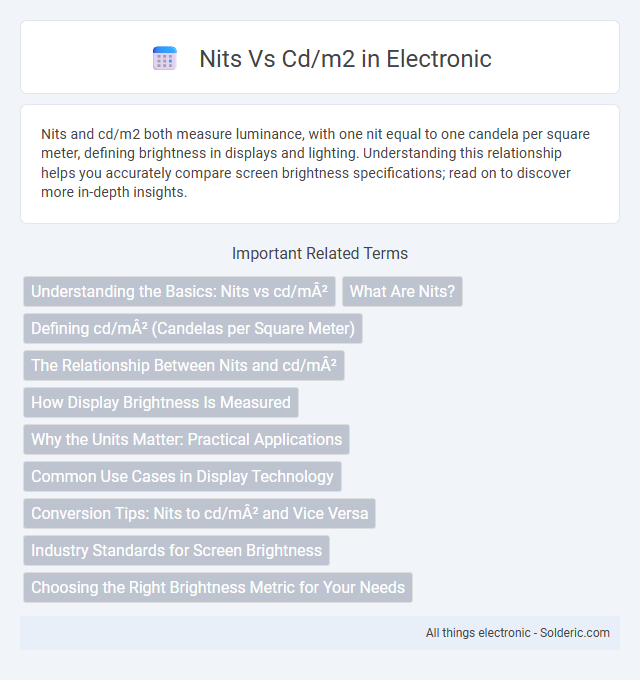Nits and cd/m2 both measure luminance, with one nit equal to one candela per square meter, defining brightness in displays and lighting. Understanding this relationship helps you accurately compare screen brightness specifications; read on to discover more in-depth insights.
Comparison Table
| Unit | Definition | Usage | Relation |
|---|---|---|---|
| Nit | Unit of luminance equal to one candela per square meter (cd/m2) | Commonly used to measure screen brightness (monitors, TVs, smartphones) | 1 nit = 1 cd/m2 |
| Candela per Square Meter (cd/m2) | SI unit of luminance measuring luminous intensity per area | Standard scientific unit for brightness measurement | Equivalent to nits for screen brightness |
Understanding the Basics: Nits vs cd/m²
Nits and cd/m2 both measure luminance, quantifying brightness per unit area with 1 nit equaling 1 candela per square meter (cd/m2). This equivalence allows consistent brightness measurement across various display technologies, ensuring accurate comparison and calibration. Understanding this relationship is crucial for optimizing screen visibility and image quality in lighting design and electronic displays.
What Are Nits?
Nits are a unit of measurement used to quantify luminance, representing candelas per square meter (cd/m2). One nit equals one candela per square meter, indicating the brightness emitted by a display screen or light source. This measurement is crucial for comparing the intensity of light output in monitors, TVs, and other digital devices, impacting visibility and image clarity under various lighting conditions.
Defining cd/m² (Candelas per Square Meter)
Cd/m2, or candelas per square meter, is the SI unit measuring luminance, which quantifies the brightness emitted or reflected from a surface. One cd/m2 equals one candela of luminous intensity distributed uniformly over an area of one square meter. This unit provides a standardized way to assess display brightness, making it essential for comparing screens, monitors, and lighting conditions accurately.
The Relationship Between Nits and cd/m²
Nits and cd/m2 both measure luminance, representing the intensity of light emitted per unit area; one nit equals one candela per square meter (cd/m2). Understanding this equivalence helps you accurately compare brightness levels for displays, ensuring optimal visibility and clarity. This direct relationship simplifies conversions across lighting specifications in screens and digital imaging.
How Display Brightness Is Measured
Display brightness is measured primarily in nits, which quantify luminance as candelas per square meter (cd/m2). One nit equals one candela per square meter, making the terms interchangeable for describing the intensity of light emitted by a screen's surface. Accurate measurement of display brightness in cd/m2 ensures consistent comparison across monitors, TVs, and smartphones, influencing visibility in various lighting conditions.
Why the Units Matter: Practical Applications
Nits and cd/m2 both measure luminance, with 1 nit equal to 1 cd/m2, providing a standardized unit crucial for display calibration and brightness consistency across devices. Accurate luminance measurement ensures optimal screen visibility in various lighting conditions, impacting user experience in smartphones, monitors, and TVs. Understanding these units aids professionals in industries like photography, broadcasting, and design to maintain color accuracy and visual performance.
Common Use Cases in Display Technology
Nits and cd/m2 both measure luminance, but nits are widely used in consumer display technology such as smartphones, televisions, and monitors to specify screen brightness levels. Common use cases include HDR content viewing, where higher nits indicate better visibility in bright environments, and outdoor displays requiring strong sunlight readability. Understanding these measurements helps you select displays optimized for your specific lighting conditions and usage scenarios.
Conversion Tips: Nits to cd/m² and Vice Versa
Nits and cd/m2 are equivalent units measuring luminance, where 1 nit equals 1 cd/m2, making conversion straightforward. To convert nits to cd/m2 or vice versa, you can use a 1:1 ratio without complex calculations, ensuring accurate brightness representation in display specifications. Understanding this direct conversion helps you compare screen brightness effectively for your visual needs.
Industry Standards for Screen Brightness
Industry standards for screen brightness commonly measure luminance in both nits and cd/m2, with 1 nit equaling 1 cd/m2, making these units interchangeable in display specifications. Consumer LCD and OLED screens typically range from 200 to 600 nits for indoor use, while HDR displays can achieve 1,000 nits or more to enhance image clarity and color accuracy under various lighting conditions. Your choice of device brightness should align with these standards to ensure optimal visibility and adherence to industry benchmarks.
Choosing the Right Brightness Metric for Your Needs
Nits and cd/m2 both measure screen brightness, but understanding their equivalence is crucial for selecting the right display. One nit equals one candela per square meter (cd/m2), meaning these terms can be used interchangeably to quantify luminance. When choosing your display, consider the environment and usage--higher nits or cd/m2 are essential for outdoor visibility, while lower values may suffice for indoor use.
nits vs cd/m2 Infographic

 solderic.com
solderic.com